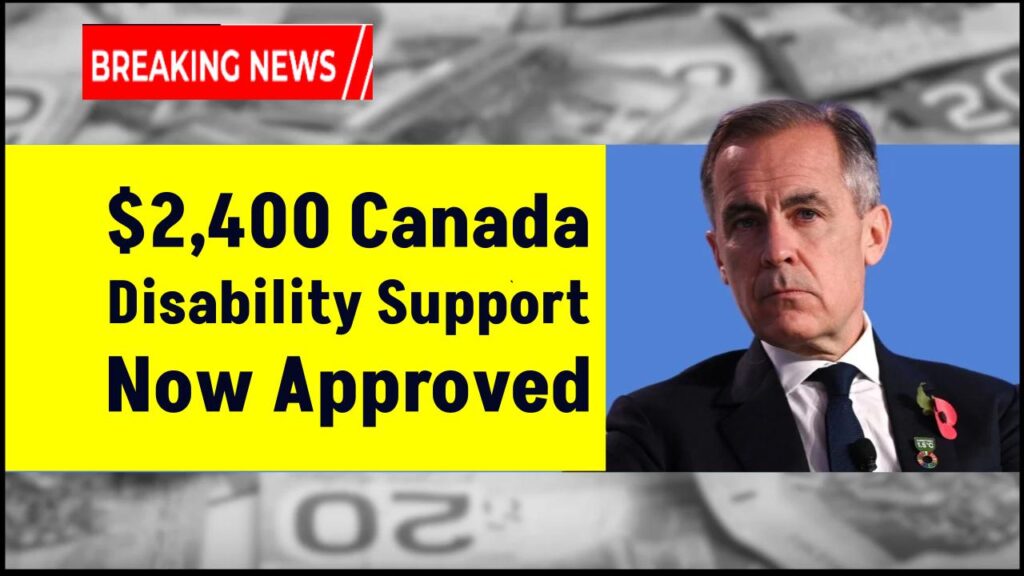Canada Disability Benefit: $2,400 Annual Support Now Approved – Do You Qualify?
Canada Disability Benefit: Canada has taken a significant step toward reducing poverty and supporting individuals with disabilities by launching the Canada Disability Benefit (CDB). This federal initiative will provide up to $2,400 annually ($200/month) to eligible low-income, working-age Canadians living with disabilities. Starting in July 2025, this benefit is a long-awaited effort to bridge financial gaps and uplift some of the country’s most vulnerable residents.

If you or a loved one lives with a disability and earns a modest income, this new benefit could make a meaningful difference. But the clock is ticking—understanding who qualifies, how to apply, and what you need to do now is essential to ensure you don’t miss out.
Canada Disability Benefit
| Feature | Details |
|---|---|
| Annual Benefit | Up to $2,400/year ($200/month) |
| First Payment Date | July 2025 |
| Eligibility Age | 18–64 years old |
| Residency | Must be a Canadian resident for tax purposes |
| Disability Status | Must have an approved Disability Tax Credit (DTC) |
| Income Thresholds | Full benefit: ≤ $23,000 (single), ≤ $32,500 (couples) |
| Working Income Exemptions | Up to $10,000 (single) and $14,000 (couples) exempted |
| Application Requirement | Must file 2024 tax return |
| Official Source | Government of Canada – CDB |
The Canada Disability Benefit is a landmark policy aiming to lift thousands of Canadians with disabilities out of poverty. With up to $2,400 per year, it can provide a much-needed safety net for those who need it most. But action is required—make sure you’re DTC-certified, file your taxes, and monitor application updates. The sooner you prepare, the better your chances of receiving the full benefit when payments begin in July 2025.
Understanding the Canada Disability Benefit (CDB)
The Canada Disability Benefit was officially approved to address financial inequality among working-age Canadians living with disabilities. Despite existing programs, many still face higher living costs, employment barriers, and inadequate provincial benefits. The CDB is designed to act as a top-up for those already struggling with low incomes, particularly those approved for the Disability Tax Credit (DTC).
This benefit was legislated under Bill C-22 and gained Royal Assent in 2023, with final regulations coming into effect May 15, 2025.
Eligibility: Who Can Apply?
Basic Eligibility Requirements
- Age: You must be between 18 and 64 years old.
- Residency: You must be a Canadian resident for tax purposes. This includes:
- Canadian citizens
- Permanent residents
- Protected persons
- Temporary residents (with at least 18 months in Canada)
- Indigenous persons registered under the Indian Act
- Disability Status: You must have an approved Disability Tax Credit (DTC) certificate.
- Income Tax Filing: You must file a 2024 income tax return. If you’re married or in a common-law partnership, your partner must also file.
Canada Disability Benefit: How Much Will You Get?
Income Thresholds for Full Benefit
- Single Individuals: Up to $23,000/year
- Couples: Combined income of $32,500/year
Employment Income Exemptions
To encourage employment, part of your work income doesn’t count against the benefit:
- Singles: Up to $10,000 of income is exempt (raising effective threshold to $33,000)
- Couples: Up to $14,000 is exempt (threshold becomes $46,500)
Benefit Reduction Rate
If your income exceeds the threshold, the benefit is reduced as follows:
- 20¢ per dollar for singles or one eligible spouse
- 10¢ per dollar if both spouses are eligible
Example: If a single person earns $25,000 (which is $2,000 over the threshold), their benefit is reduced by $400 annually (20% of $2,000), resulting in $2,000 total for the year.
Step-by-Step: How to Prepare for the Canada Disability Benefit
1. Apply for the Disability Tax Credit (DTC)
- Visit Canada DTC Guide
- Ask your doctor to complete the T2201 DTC Certificate
- Submit to the CRA (Canada Revenue Agency)
2. File Your 2024 Taxes
- Even if you have no income, file your 2024 return in early 2025.
- If you have a spouse, they must also file.
3. Gather Documents
- Keep records of your:
- Disability status
- Income
- Residency and ID
4. Watch for Application Details
- Service Canada will release application procedures in early 2025.
- Check updates at the Canada Disability Benefit Portal.
Important Dates to Remember
| Date | Milestone |
|---|---|
| May 15, 2025 | Regulations take effect |
| June 2025 | First month of eligibility |
| July 2025 | First payments issued |
Things to Watch Out For
Potential Clawbacks
Some provincial or private disability benefits may reduce their payments due to the CDB. Advocates are pressuring provinces to prevent clawbacks.
DTC Challenges
The Disability Tax Credit can be hard to get—especially for those with invisible, episodic, or mental health-related disabilities. The government has pledged to cover medical form costs, but details remain unclear.
CPP Payments Changing Soon: Full Breakdown of What’s Happening Between Feb and May 2025
Extra GST Payment Scheduled for May 2025 – Check Eligibility Criteria!
$650 GST Payment Boost Coming in 2025 — Are You Eligible for the Extra Money?
FAQs on Canada Disability Benefit
Do I need to apply for the CDB?
Yes. Even if you have the DTC, you will need to apply through Service Canada once the application process opens in 2025.
Will this affect my provincial disability benefits?
It might. Provinces have not all confirmed if they’ll exempt the CDB from income calculations.
How long does it take to get the DTC?
Approval can take 8–12 weeks, depending on medical form processing and CRA review times.
Can children receive the Canada Disability Benefit?
No. The CDB is only for individuals aged 18–64.







